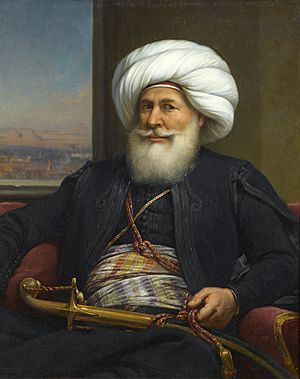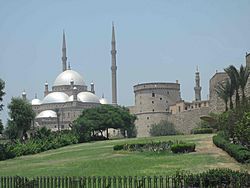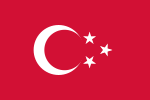Muhammad Ali Pasha facts for kids
Quick facts for kids Muhammad Ali Pasha |
|
|---|---|
| Wāli of Egypt, Sudan, Palestine, Syria, Hejaz, Morea, Thasos, Crete | |
 |
|
| Reign | 17 May 1805 – 2 March 1848 |
| Successor | Ibrahim Pasha |
| Born | 4 March 1769 Kavala, Macedonia, Rumeli eyalet, Ottoman Empire (present-day Greece) |
| Died | 2 August 1849 (aged 80) Ras el-Tin Palace, Alexandria, Egypt |
| Albanian | Mehmet Ali Pasha |
| Arabic | محمد علي باشا |
| Turkish | Kavalalı Mehmet Ali Paşa |
| Dynasty | Muhammad Ali Dynasty |
| Religion | Islam |
Muhammad Ali Pasha (born March 4, 1769 – died August 2, 1849) was an Albanian commander. He served in the Ottoman army. He later became the ruler, or Wāli, of Egypt and Sudan. He even called himself Khedive, which is like a viceroy.
Even though he wasn't a modern nationalist, Muhammad Ali is known as the founder of modern Egypt. This is because he made huge changes to Egypt's army, economy, and culture. He also ruled some areas in the Middle East outside Egypt. The family he started ruled Egypt and Sudan until the Egyptian Revolution in 1952.
Muhammad Ali was born in the Ottoman Empire. This area is now part of Greece. His parents were Albanian, and Albanian was the only language he spoke well. He also knew some Turkish, but not Arabic. He led a group of Albanian soldiers to Egypt. They were part of an Ottoman army that took back Egypt after Napoleon's French troops left. Before this, the Ottomans ruled Egypt through a governor (Wali) and Mamluk soldiers. The Mamluks were once slaves.
When the French left Egypt, there was no clear ruler. The Mamluks were weaker but still powerful. Ottoman forces and Mamluks fought for control. During this time, Muhammad Ali used his loyal Albanian soldiers. He played both sides, which helped him gain power and respect. As the fighting continued, the local people grew tired of the struggle. In 1805, a group of important Egyptians asked the current Wali, Ahmad Khurshid Pasha, to step down. They wanted Muhammad Ali to become the new Wali.
Contents
Muhammad Ali's Reforms in Egypt
Muhammad Ali wanted to build a strong, modern country like those in Europe. To do this, he needed to change Egyptian society. He also wanted to improve the economy, create a professional government, and build a modern army.
Muhammad Ali changed how land was used and controlled trade in Egypt. He made all farmers sell their goods to the state. The state then sold these goods again and kept the extra money. This made Egypt very rich, especially from its high-quality cotton. Farmers also benefited, as their average pay went up a lot.
Besides improving the economy, Muhammad Ali started training a professional army and government workers. He sent smart young men to Europe to study. They learned European languages, mostly French. This helped them translate military books into Arabic. He then used these educated Egyptians and experts from Europe to open schools and hospitals in Egypt. This European education also helped talented Egyptians from poor families rise up and become successful.
Muhammad Ali's training program also created a civil service. This was a system of government workers. An efficient central government was needed for all his other changes. After defeating the Mamluks, Muhammad Ali had to fill the jobs they used to do. He divided Egypt into ten areas, called provinces. Each leader was in charge of collecting taxes and keeping order. Muhammad Ali put his sons in most important jobs. However, his changes also gave Egyptians new chances beyond farming and factories.
Muhammad Ali's Military Campaigns
At first, Muhammad Ali fought wars for the Ottoman Sultan, Mahmud II. These wars were in Arabia and Greece. Later, he fought against the Ottoman Empire itself.
Campaigns in Arabia
His first military mission was to the Arabian Peninsula. The holy cities of Mecca and Medina had been taken by the House of Saud. This group followed a strict form of Islam called Wahhabism. With their strong religious beliefs, the Saudis started taking over parts of Arabia.
The main Ottoman army was busy fighting in Europe. So, Sultan Mahmud II asked Muhammad Ali to take back the Arabian lands. Muhammad Ali sent his son, Tusun Pasha, to lead an army in 1811. This first attempt failed. However, a second attack in 1812 successfully recaptured Hejaz. After two years of fighting, the Saudis were defeated. Most of the Saudi family was captured. Their leader, Abdullah ibn Saud, was sent to Istanbul and executed.
Conquest of Sudan
Next, Muhammad Ali focused on his own military goals. He wanted to conquer Sudan. He saw Sudan as a valuable place for new land, gold, and slaves. At that time, Sudan had no strong central government. Its tribes often fought using simple weapons.
In 1820, Muhammad Ali sent an army of 5,000 soldiers into Sudan. His third son, Ismail, led this army. Their goal was to conquer the land and bring it under Egyptian rule. Ali's troops moved into Sudan in 1821. But they faced strong resistance. In the end, Egyptian soldiers and firearms won the conquest of Sudan. Ali now had a base to expand towards the source of the Nile River in Ethiopia and Uganda. His government captured slaves from Sudan. These slaves were then trained to become soldiers. Muhammad Ali's harsh rule in Sudan, and that of his sons, later led to a fight for independence. This struggle was led by Muhammed Ahmed in 1881.
Fighting in Greece
While Muhammad Ali was expanding into Africa, the Ottoman Empire faced rebellions in Europe. The rebellion in the Greek areas of the Ottoman Empire began in 1821. The Ottoman army could not stop the revolt. Violence spread even to Constantinople. Sultan Mahmud II offered Muhammad Ali the island of Crete. In return, Muhammad Ali had to help put down the revolt.
Muhammad Ali sent 16,000 soldiers, 100 transport ships, and 63 escort ships. His son, Ibrahim Pasha, commanded them. But Britain, France, and Russia stepped in to protect the Greeks. On October 20, 1827, at the Battle of Navarino, the entire Egyptian navy was destroyed. European Allied ships, led by Admiral Edward Codrington, sank it. Muhammad Ali lost his strong and expensive navy. With no fleet, Egypt could not support its forces in Greece and had to leave. This campaign cost Muhammad Ali his navy, and he gained nothing.
Taking Control of Syria
To make up for his losses, Muhammad Ali decided to conquer Syria. Like other rulers of Egypt before him, Ali wanted to control the Levant region. This area was important for its location and its rich natural resources. Syria had many resources and a busy international trading community. It would be a new market for goods made in Egypt. Also, Syria would act as a protective zone between Egypt and the Ottoman Sultan.
A new fleet was built, and a new army was formed. On October 31, 1831, the Egyptian invasion of Syria began. This started the First Turko-Egyptian War. The Egyptians quickly took over most of Syria. The strongest resistance came from the port city of Acre. The Egyptian army finally captured the city after a six-month siege. During the siege, there was growing unrest back home in Egypt. Ali had to put more and more pressure on Egypt to support his campaign. His people did not like this extra burden.
After Acre fell, the Egyptian army marched north into Anatolia. At the Battle of Konya (December 21, 1832), Ibrahim Pasha easily defeated the Ottoman army. There were no more military obstacles between Ibrahim's forces and Constantinople itself.
During this campaign, Muhammad Ali watched the European powers carefully. He feared another intervention that would undo all his gains. So, he moved slowly and cautiously. For example, he continued to use the Sultan’s name in prayers in the newly captured areas. He also kept using Ottoman coins instead of making his own. As long as Muhammad Ali's advance did not threaten to completely destroy the Ottoman state, European powers did not interfere.
Despite this careful approach, Muhammad Ali now wanted to remove the current Ottoman Sultan, Mahmud II. He wanted to replace him with the Sultan's young son, Abdülmecid. This possibility worried Mahmud II so much that he accepted Russia's offer of military help. This led to the Treaty of Hünkâr İskelesi. Russia's gain upset the British and French governments. So, they worked for a peaceful solution. In May 1833, the Convention of Kutahya was signed.
The peace terms stated that Ali would pull his forces out of Anatolia. In return, he would receive the territories of Crete and the Hijaz. Ibrahim Pasha would be made the ruler (Wāli) of Syria. However, this peace agreement did not give Muhammad Ali an independent kingdom. This left him still wanting more.
Images for kids
-
Muhammad Ali's birthplace in Kavala, now in northeastern Greece.
-
Muhammad Ali Pasha with his son, Ibrahim, and Colonel Joseph Sève (later Suleiman Pasha).
-
Interview with Mehmet Ali in his Palace at Alexandria (1839), with Patrick Campbell in the centre. After David Roberts, in The Holy Land, Syria, Idumea, Arabia, Egypt, and Nubia
-
A portrait of Muhammad Ali of Egypt by David Wilkie (1841).
See also
 In Spanish: Mehmet Alí para niños
In Spanish: Mehmet Alí para niños











